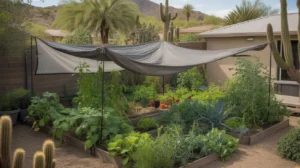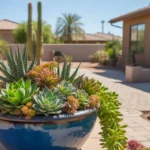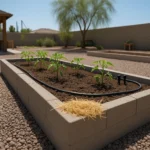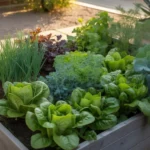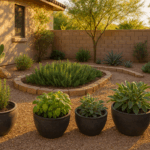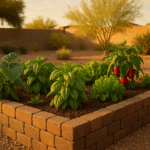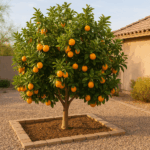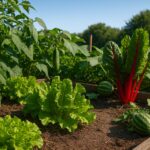Gardening in the intense sun and heat of the Southeast Valley can be a challenge, especially when it comes to growing vegetables. The scorching temperatures and relentless sun can quickly wilt and damage delicate plants, making it difficult to maintain a thriving garden. However, there is a simple solution that can help protect your vegetables and keep them healthy: shade cloth. By utilizing shade cloth strategically in your vegetable garden, you can create a more hospitable environment for your plants and enjoy a bountiful harvest even in the hottest months.
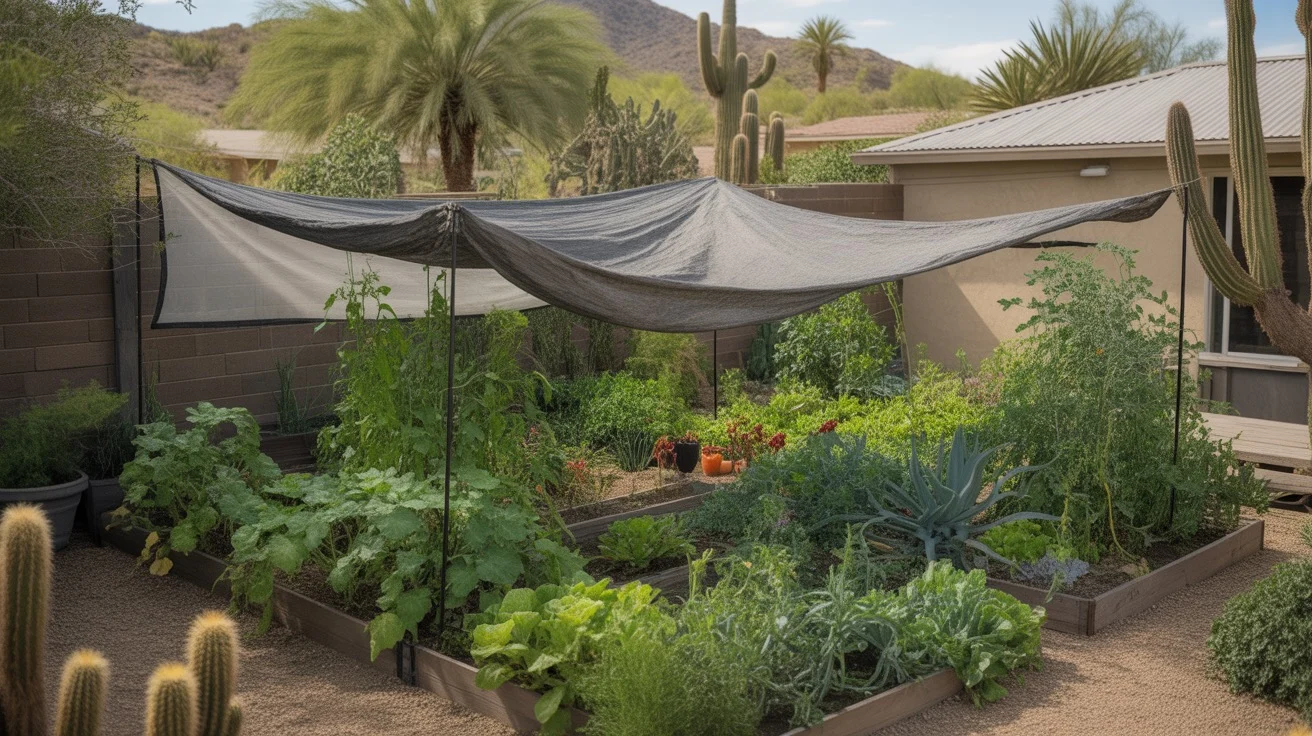
Understanding the Benefits of Shade Cloth
Shade cloth is a lightweight, breathable fabric that is designed to block a portion of the sun’s rays while still allowing air and water to pass through. It comes in various densities, typically ranging from 30% to 90% shade, allowing you to choose the level of protection that best suits your garden’s needs. By using shade cloth, you can reduce the intensity of the sun’s rays and lower the temperature in your garden by several degrees.
One of the primary benefits of using shade cloth in your Southeast Valley vegetable garden is that it helps prevent sunscald. Sunscald occurs when the intense sun directly hits the leaves and fruits of your plants, causing them to develop pale or white patches and eventually dry out and die. By providing a barrier between your plants and the harsh sun, shade cloth can minimize the risk of sunscald and keep your vegetables looking healthy and vibrant.
In addition to preventing sunscald, shade cloth can also help regulate soil temperature and moisture levels. When the sun beats down on bare soil, it can quickly dry out and become excessively hot, stressing the roots of your plants. By covering the soil with shade cloth, you can maintain a more consistent temperature and retain moisture, creating a more favorable environment for your vegetables to grow.
Choosing the Right Shade Cloth Density
When selecting shade cloth for your Southeast Valley vegetable garden, it’s important to consider the density that will best meet your plants’ needs. The density of shade cloth refers to the percentage of sunlight it blocks. For example, a 30% shade cloth will allow 70% of the sun’s rays to pass through, while a 70% shade cloth will only allow 30% of the light to reach your plants.
In the intense heat of the Southeast Valley, a 50% to 60% shade cloth is often recommended for most vegetable gardens. This level of shade provides a good balance between sun protection and allowing enough light for photosynthesis. However, the ideal density may vary depending on the specific vegetables you are growing and their individual light requirements.
Leafy greens, such as lettuce and spinach, can benefit from a higher density shade cloth, around 60% to 70%, as they are more sensitive to heat and sun damage. On the other hand, fruiting vegetables like tomatoes and peppers may prefer a slightly lower density, around 40% to 50%, to ensure they receive enough light for optimal fruit production. Observing your plants’ response to the shade and adjusting the density accordingly can help you find the perfect balance for your garden.
Proper Installation and Placement of Shade Cloth
To maximize the benefits of shade cloth in your Southeast Valley vegetable garden, it’s crucial to install it correctly and position it strategically. One effective method is to create a shade structure using PVC pipes or sturdy wooden frames. By constructing a frame that extends over your garden beds, you can securely attach the shade cloth and create a consistent level of shade for your plants.
When installing shade cloth, ensure that it is taut and secure to prevent sagging or flapping in the wind. Loose shade cloth can cause damage to your plants and may not provide the desired level of protection. Use zip ties, clips, or other fasteners to attach the shade cloth to the frame, making sure it is evenly distributed and covers the entire area you want to protect.
In terms of placement, it’s generally best to position the shade cloth on the south and west sides of your garden, as these are the directions from which the sun’s rays are most intense during the hottest parts of the day. By shading your plants during the peak hours of sunlight, typically from late morning to late afternoon, you can provide them with much-needed relief and minimize the risk of heat stress and sun damage.
Timing and Seasonal Adjustments
The timing of when to use shade cloth in your Southeast Valley vegetable garden depends on the specific needs of your plants and the intensity of the sun throughout the growing season. In general, it’s a good idea to have your shade cloth ready to install by late spring or early summer, when temperatures begin to soar and the sun’s rays become more intense.
Keep an eye on the weather forecast and be prepared to deploy your shade cloth when prolonged periods of extreme heat are expected. You may also want to consider using shade cloth during the hottest months of July and August, when even heat-tolerant vegetables can struggle to cope with the relentless sun and high temperatures.
As the seasons change and the intensity of the sun decreases, you may need to adjust your shade cloth accordingly. In the cooler months of fall and winter, your plants may benefit from more direct sunlight to support their growth and development. Be prepared to remove or reduce the density of your shade cloth during these times to ensure your vegetables receive the optimal amount of light for their needs.
Combining Shade Cloth with Other Heat-Mitigating Techniques
While shade cloth is an effective tool for protecting your vegetables from the intense Southeast Valley sun, it works best when combined with other heat-mitigating techniques. One such technique is mulching. By applying a layer of organic mulch around your plants, you can help retain soil moisture, regulate soil temperature, and reduce water evaporation. Straw, leaves, or compost can all make excellent mulches for your vegetable garden.
Another strategy is to practice deep and infrequent watering. Instead of watering your plants shallowly and frequently, aim to water deeply and less often. This encourages your plants to develop deeper root systems, making them more resilient to heat and drought stress. Water your garden early in the morning or late in the evening to minimize evaporation and allow the water to penetrate deeply into the soil.
Companion planting can also help create a more hospitable microclimate in your vegetable garden. By strategically placing taller plants, such as sunflowers or corn, on the south and west sides of your garden, you can provide additional shade for your more delicate vegetables. As the sun moves across the sky, the taller plants will cast shadows, offering respite from the intense rays and helping to regulate temperatures in your garden.
Monitoring and Adjusting as Needed
Gardening in the Southeast Valley requires adaptability and attentiveness to your plants’ needs. As you implement shade cloth in your vegetable garden, be sure to monitor your plants closely and observe their response to the increased shade. Look for signs of improved health, such as vibrant green leaves, robust growth, and reduced wilting or sun damage.
If you notice that your plants are still struggling despite the shade cloth, consider adjusting the density or placement of the cloth. You may need to experiment with different levels of shade to find the optimal balance for your specific garden and the vegetables you are growing. Don’t be afraid to make adjustments throughout the season as the sun’s intensity changes and your plants’ needs evolve.
Remember, the key to success with shade cloth in your Southeast Valley vegetable garden is finding the right combination of protection and light that allows your plants to thrive. By providing your vegetables with the shade they need to withstand the intense sun and heat, you can create a more resilient and productive garden that yields a bountiful harvest season after season.

